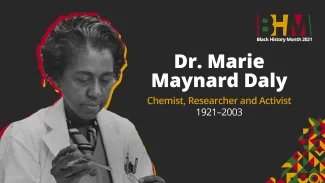Courage is a habit, a virtue: you get it by courageous acts. It’s like you learn to swim by swimming. You learn courage by couraging.
As part of our Black figures within STEM series, in this blog post we’ll be focusing on Dr. Marie Maynard Daly, a pioneer within the field of chemistry.
Marie Maynard Daly carried out groundbreaking research on the cell nucleus, after being the first Black woman in the USA to receive a doctoral degree (from Columbia University). She received this in 1947, after graduating from Queens College in Flushing, New York. It was at Howard University where she first began her work on the metabolism and composition of components within the cell nucleus, whilst holding a position as an instructor.
She worked on her research on the cell nucelus for seven years amongst other studies, and then took up a position teaching biochemistry at Columbia University within the College of Physicians and Surgeons. After a further 26 years teaching at the Albert Einstein College of Medicine, Daly retired in 1986.
Not only is her work within the field of chemistry well-recognised, but Dr. Maynard Daly also carried out a vast amount of activist work later in her life, creating scholarship funds and programmes that would help to increase the numbers of Black students able to study Science and Medicine. The scholarship fund that she established at Queens College for African Americans is in commemoration to Daly’s father – a gesture that speaks volumes of the attitude of selflessness that she embodied throughout her life.
Throughout Dr. Daly’s academic career she had to overcome prejudice from the world she found herself in both for her race, and for her gender. She therefore understood fully what it was to be an outsider, and to be treated as such, and the commitment she showed to make career paths within science and medicine more accessible to students from minority backgrounds was testament to that.
